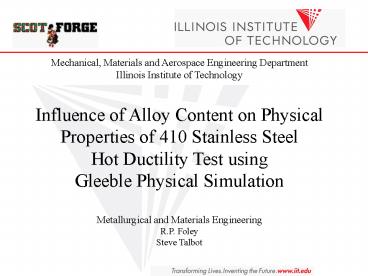Illinois Institute of Technology TPTC PowerPoint PPT Presentation
1 / 23
Title: Illinois Institute of Technology TPTC
1
Mechanical, Materials and Aerospace Engineering
DepartmentIllinois Institute of
TechnologyInfluence of Alloy Content on
Physical Properties of 410 Stainless Steel Hot
Ductility Test using Gleeble Physical
SimulationMetallurgical and Materials
EngineeringR.P. FoleySteve Talbot
2
Background
- Objective
- Determine effect of two sulfur contents on 410
Stainless Steel. - Strategy
- Hot Ductility tensile fracture tests with Gleeble
3500 - Data analysis
- Key Parameters of Hot Tensile Test
- Maximum Force (tensile), kgf
- Fracture Temperature (1500 2200), oF
- Stroke ( D length of sample), inches
- Tensile Samples
- As received and turned in IIT machine shop
- 123 samples tested
3
Background
1 11/16 Typ
40
7 5/8
B
A, B, 1A, 1B
Extra
2A, 2B
(left at Scot Forge)
A
12
12
16
3/8 Typ
4 1/2
4
Background
- Batch 1 Higher sulfur content, more data with 2A
and 2B - Batch 2 Lower sulfur content, baseline chemistry
5
Gleeble 3500
- The Gleeble 3500 is a fully integrated digital
closed loop control thermal and mechanical
testing system. - Heating rate, 10,000C/second.
- hydraulic servo system, up to 10 tons of tension
or compression. - Stroke displacement rates as fast as
1000mm/second. - LVDT transducers and load cells provide feedback
to insure accurate execution and repeatability. - Controls and records stroke displacement, applied
force, measured temperature, applied temperature,
and other key engineering parameters.
6
(No Transcript)
7
Gleeble 3500
- QuikSim Software allows programming of waveforms
with speadsheet efficiency for both thermal and
mechanical physical simulations. - Gleeble Script Language augments QuikSim with
manual programming of complicated simulations. - Origin, data analysis software package, stores
the test data or transfers the data into an MS
Excel file.
8
Test Setup and Run
- Measure nominal diameter.
- Attach thermocouple wires.
- Match relative to absolute Force gages.
- Load the sample into Gleeble 3500.
- Zero relative Stroke gage.
- Run GSL script.
- Monitor test progress.
- Examine sample fracture.
- Measure fracture diameter.
- Store sample for future examination.
9
Trial Run of Sample
- Initialize test parameters
- Vacuum the test chamber (40 mmHG)
- Apply nitrogen gas environment (5 mmHG)
- Use G.S.L.s Force Control to ensure
- zero force on sample throughout heating
stages. - Ramp to Soak Temperature,
- (2200 oF at 50 oF/s in 22 s).
- Hold at Soak Temperature,
- (2200 oF for 600 s).
- Ramp to Fracture Temperature,
- (1500 oF 2200 oF at 50 oF/s).
- Use G.S.L.s Stroke Control 2 in/s fracture
rate - Cool sample unassisted.
- Vent the test chamber of nitrogen gas.
10
Trial Run of Sample
11
Profile of Material
Soak 600s at 2200 F
Casting and Hot Forging at Scot Forge
Cool to Fracture Temp, 50 F/s
15 samples, 50 F intervals, 1500 F 2200 F
Fracture Temp Range
Heat 50 F/s
2 in/s fracture rate
Arrives at IIT
12
Ductility
Temperature
13
(No Transcript)
14
(No Transcript)
15
(No Transcript)
16
(No Transcript)
17
(No Transcript)
18
Test Results
- R.A. Standard Measure of Hot Ductility
- Linear increase in R.A. with Fracture
Temperature - (40 Batch 1, 55 Batch 2 to 90 Both
Batches) - Data spread scattered.
- Maximum Force
- Linear decrease in Maximum Force with Fracture
Temperature. - (650 to 250 Kgf)
- 1B Mid Radius Force Control source of
experimental error
19
Test Results
- Max-Force Stroke
- Stroke constant at maximum force for all samples
over - Fracture Temperature range, beyond which
necking occurs. - (0.23 inches).
- Baseline ?less? ductile at both 1500 oF and 2200
oF. - Data spread scattered as R.A.
- Fracture Stroke
- Linear increase in Stroke at fracture with
Fracture Temperature. - ( 0.26 to 0.42 inches).
- Sudden drop in baseline Hot Ductility at 2050 oF.
- Baseline ?less? ductile at 1500 oF but more
ductile at 2200 oF. - Corresponds well with R.A. with less variability
in data.
20
Test Results
- Fracture Center Diameter
- A smaller fracture diameter is more ductile.
- Diameter constant below 1700 oF.
- Linear increase in Diameter with Fracture
Temperature. - (0.16 Batch 1, 0.18 Batch 2 at 1500 oF to
- 0.07 Batch 1, 0.10 Batch 2 at 2200 oF)
- Sudden rise in Fracture diameter at 2050 oF
corresponds to - dip of Fracture Stroke at 2050 oF.
- Data spread less variable than R.A.
21
Conclusions
- Additional sulfur in batch 1 decreases Hot
Ductility - R.A. below 2000 oF.
- Fracture Stroke Fracture Center Diameter below
1700 oF. - Hot Ductility lessened due to ability of sulfur
to impede dislocation motion in the form of
interstitial substitution in crystal lattice. - Data for Batch 1 has less variability and more
linearity - Gleeble measurements of Hot Ductility (Max-Force
Stroke, Fracture Stroke) can be used
qualitatively in association with R.A., and
match in variability of results. - Maximum Force linear decrease Max-Force Stroke
constant. - Reinforces elastic linearity of force vs
displacement test
22
Further Developments
- Examination of fracture techniques.
- X-Ray Fractography
- S.E.M.
- Determination of fracture initiation and fracture
mechanism. - Sulfur content influence.
- Temperature relationship.
23
End
Thank You

